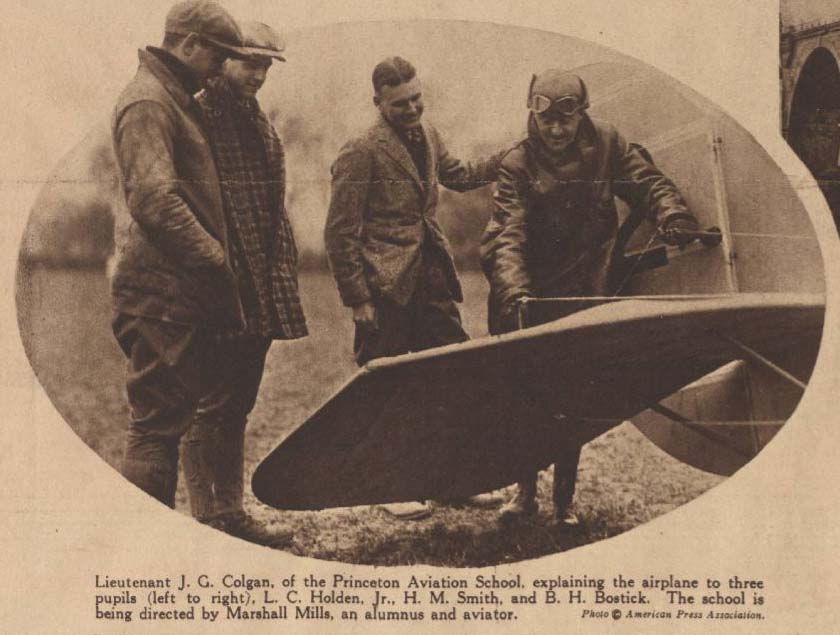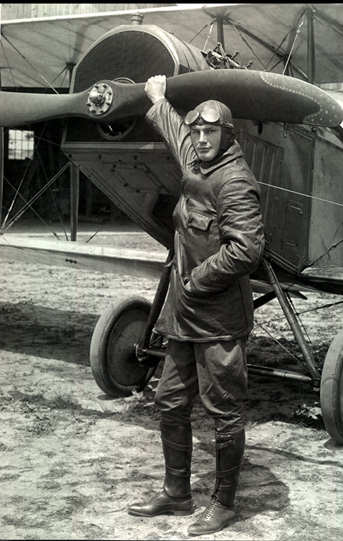(Jasper County, South Carolina, September 1, 1898 – Columbia, South Carolina, October 25, 1968).1
Bostick’s forebears on both his father’s and his mother’s (Hagood) side had been in South Carolina since the eighteenth century; his father was manager at the exclusive Okeetee Club, a quail-hunting plantation in Jasper County near the Georgia border.2 Bostick prepared for college at The Asheville School for Boys in North Carolina and then proceeded farther north to attend Princeton (class of 1919).3

He was a student at the Princeton Aviation School, which had been established in the spring of 1917 to train Princeton students, and then became a member of the first class at the Princeton School of Military Aeronautics (“ground school”) which superseded the Aviation School in June 1917, graduating August 25, 1917.4 Bostick, Elliott White Springs, and others from this class went from Princeton to an army training field at Mineola on Long Island where Springs worked out a deal that allowed him, Harold Kidder Bulkley, and Bostick to get in more time in the air.5
Having, along with other members of his Princeton ground school class, signed up to go to Italy for advanced training, Bostick set sail September 18, 1917, from New York on the Carmania as one of the 150 men of the “Italian” or “second Oxford detachment.” Soon after the Carmania docked at Liverpool on October 2, 1917, they learned they were to train not in Italy, but England. The month of October was taken up with attending ground school (again) at the Royal Flying Corps’s No. 2 School of Military Aeronautics at Oxford.
In early November most of the men in the detachment went from Oxford to Grantham to attend machine gun school. Bostick, however, was among the twenty men selected by Springs to go with him to No. 1 Training Depot Station at Stamford to begin flying instead; most of them had already had some flying experience and would continue their flying training at No. 1 T.D.S.6
Bostick’s R.A.F. service record does not list his training squadrons, but notes the planes he had flown: Curtiss Jennys (which were used for training both at Princeton and at Stamford), Avros, Sopwith Pups, and Sopwith Camels, and that he had a general knowledge of Vickers and Lewis machine guns. By mid-February, Bostick had evidently fulfilled the requirements for a commission; Pershing’s cable forwarding the recommendation is dated February 21, 1918. The confirming cablegram is dated March 2, 1918.7 On March 20, 1918, when he was placed on active duty, Bostick was at Wye in Norfolk, probably at No. 42 Training Squadron, where scout pilots trained on Camels.7a
An entry in War Birds for March 26, 1918, indicates that in March Bostick was in Scotland: “Hagood Bostick came down here [Ayr] from Turnberry looking like the Queen of Sheba’s favorite husband. He had on everything but the monocle to make him Hinglish. He had pale pink breeches, light tan tunic with skirts down to his knees and boots and gloves and cane to match. He comes from Charleston, S.C., so doesn’t have to cultivate the accent. Plucky little kid, he’s only nineteen.”
 Bostick, along with Errol Henry Zistel of the first Oxford detachment, was assigned to No. 2 Aeroplane Supply Depot on April 4, 1918, and from there both were assigned to No. 43 Squadron R.A.F. on April 8, 1918.7b George Clark Whiting and Henry Robinson Clay, also of the first Oxford detachment, were already assigned to No. 43, a Camel squadron, which, since March 22, 1918, had been at Avesnes-le-Comte (about ten miles west of Arras).8
Bostick, along with Errol Henry Zistel of the first Oxford detachment, was assigned to No. 2 Aeroplane Supply Depot on April 4, 1918, and from there both were assigned to No. 43 Squadron R.A.F. on April 8, 1918.7b George Clark Whiting and Henry Robinson Clay, also of the first Oxford detachment, were already assigned to No. 43, a Camel squadron, which, since March 22, 1918, had been at Avesnes-le-Comte (about ten miles west of Arras).8
On April 11, 1918, soon after arriving at No. 43, Bostick was seriously injured when he crashed Sopwith Camel D6518 during landing practice.9 Concussed, and with wounds to the face and knee, he was sent to the British No. 8 General Hospital at Rouen on April 19, 1918; three days later, he was sent back to England on the Carisbrook Castle and admitted to the R.A.F. Central Hospital in London.9a Joseph Kirkbride Milnor, who was working at American Aviation HQ in London, noted in his diary on April 27, 1918, that he “Went out to Hampstead to see Bostick who is back from France as result of a terrible crash.” Springs encountered Bostick in early May and gives a good account of his recovery in a May 7, 1918, letter to his (Springs’s) stepmother.10 Excerpts from a letter dated May 24, 1918, that Bostick wrote to his parents were printed in a South Carolina newspaper in July 1918.11 He gives a gruesome description of his injuries and a cheerful account of his progress towards recovery, but few details of the accident itself. He writes that his main concern was “being out of the swing for the time being. I was present at the birth of our air service and I want to see it through to the end when it has outgrown the signal corps and even the army and becomes a new service on a footing with the army and navy.” According to his R.A.F. service record, Bostick was declared fit for flying duties in July. In late October he was sent to the Central Flying School for a refresher course on Camels. The war ended before he could return to the front.
Bostick sailed for the U.S., along with a number of other men of the second Oxford detachment, on the Mauretania, departing Liverpool on November 25, 1918, and arriving at New York on December 2, 1918.12 He returned to South Carolina and initially went into business processing peanuts; he then moved into advertising.13
mrsmcq April 27, 2017; updated August 20, 2020, to reflect Milnor diary
Notes
(For complete bibliographic entries, please consult the list of works and web pages cited.)
1 Bostick’s date of birth is taken from The National Archives (United Kingdom), Royal Air Force officers’ service records 1918-1919, record for Bonham Hagood Bostick; and from Ancestry.com U.S., Social Security Death Index, 1935-Current, record for Bonham H. Bostick. The transcription of an obituary for him from The State gives September 2, 1898, as his date of birth (see Anna, “Bonham Hagood Bostick”). His place of birth is taken from the transcribed obituary, his place and date of death from the Social Security Death Index record. The photo is a “shot taken by Orren Jack Turner printed from the original glass plate negative,”presumably taken at Princeton in 1917. It was posted by “njaviators” (Michael O’Neal) in 2009 on the discussion thread “WW1 ‘Foggione’ Pilot, Allen Bevin.”
2 Documents relating to Bostick’s family are available at Ancestry.com. On his father, see Perry, Moving Finger of Jasper, p. 153.
3 Asheville School, Yearbook of Asheville School, Asheville, N.C., Founded, 1900: 1915–1916, pp. 28 and 36; The Princeton Bric-a-Brac 1918, p. 51.
4 See The Princeton Bric-a-Brac 1919, pp. 85-87, and “Ground School Graduations [for August 25, 1917].”
5 See Springs, Letters from a War Bird, p. 31.
6 See Neely, Diary, entry for November 1, 1917.
7 Cablegrams 631-S and 857-R.
7a Biddle, “Special Orders No. 35.” On 42 T.S. see MickDavis’s contribution to “42 TRAINING SCHOOL RAF/RFC.”
7b These dates are taken from Bostick’s and Zistel’s casualty forms (“Lieut. B. H Bostick United States Air Service”; “2nd Lieut., Lieut. E H Zistell USAS”).
8 See Munsell, Air Service History, pp. 215 and 206 (30 and 21), regarding Whiting, and Clay. On 43’s location, see Philpott, The Birth of the Royal Air Force, p. 405.
9 See Henshaw, The Sky Their Battlefield II, entry for Bostick on April 11, 1918, in “Accidents Addendum.” The plane was badly damaged and struck off charge (see entry for D6518 at Pentland, Royal Flying Corps).
9a See “Bonham, H.B. (Hagood Bostick),” “Bostick, B.H. (B. Hagood),” and Bostick’s R.A.F. service record and his casualty form, both cited above.
10 Springs, Letters from a War Bird, p. 122.
11 “Letter from Aviator.” The obituary transcribed at Anna, “Bonham Hagood Bostick,” states that “Bostick’s plane crashed in battle, reportedly from the concussion wash of a German ‘Big Bertha’ shell”; this is almost certainly fabrication.
12 War Department, Office of the Quartermaster General, Army Transport Service, Lists of Incoming Passengers, 1917 – 1938, Passenger list for casual officers, Air Service, on Mauretania.
13 See obituary transcribed at Anna, “Bonham Hagood Bostick.”

